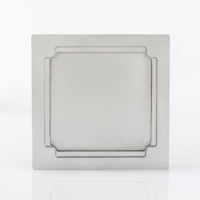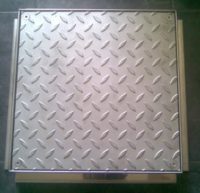FEATURES
Tapalum 2006 S.L complies with the EN 1253 standard: EN 1253 comes to alleviate the deficiencies of the almost universal reference standard, EN 124, which does not contemplate the specifications for when these covers are placed inside buildings
The EN 124 Standard has become the almost universal reference for manhole covers. Its objective is to regulate the design and functionality of the covering and closing devices for circulation areas used by vehicles, in fact, to reference all types of manhole covers. The best known aspect of this standard is the classification it establishes based on the place of installation and the resistance that must be required. However, it sets other types of specifications and limitations that, being suitable for a device to be installed outside, can be counterproductive for a cover that will be placed inside a building. Therefore, it is not surprising that manufacturers of interior access covers have discarded this standard and designed them according to their own criteria. The EN 1253 standard comes to alleviate these deficiencies. It classifies the sumps and siphons, sets guidelines regarding the places of installation and specifies the requirements for their design and manufacture, regardless of the material used for their production. Specifically, the fourth part of this standard refers to access covers. Specifically, it regulates two fundamental aspects: the resistance that they must withstand depending on their place of installation and the level of tightness. In addition, it establishes the tests that must be carried out and sets the guidelines for marking the products. Regarding resistance, it establishes the following classification:
• Class H 1.5: unused flat roofs, such as gravel and felt-lined roofs, gravel-filled roofs and the like.
• Class K 3: areas without vehicle traffic, such as public bathrooms or showers, balconies, galleries, terraces and covered with vegetation.
• Class L 15: areas with light vehicle traffic, excluding forklift trucks, used in commercial areas.
• Class M 125: areas with vehicular traffic, such as parking lots, factories and workshops.
• In areas where the covers are subjected to special stresses, such as exhibition halls, markets, factory sheds and aircraft hangars, classes C 250 to F 900 of the EN 124 Standard will be used. Regarding sealing, they are grouped into these classes:
• Wt class: watertightness. The covers must prevent the entry of rainwater that does not exert hydrostatic pressure. • Class Ot: tightness to odors. The covers must prevent the escape of stale air.
• Class Bt: backflow tightness. In the event of overloading of the drainage system, the covers must prevent the water from escaping for a pressure of 0.5 bar. In short, the installation of manhole covers in buildings that comply with the requirements of the EN 1253 Standard will ensure the comfort of its occupants and provide security for those who prescribe and install them.
RATES
Aluminum manhole covers hermetic and reversibles
They are suitable for indoor installations and outdoor garden areas, (for the protection of electrical and recordable connections
and other complementary options such as the pocerias sector)Available in sizes from 20cm x 20cm to 100cmx100cm in reversible format.
In general, aluminum resists corrosion well in the following media: NH4OH, acetic acid and many organic acids, fatty acids, nitric acid >80%, distilled water, non-marine atmosphere, sulfur and sulphurous atmospheres and sulphurous refrigerant gases.
The same does not happen with materials such as galvanized or PVC or with manhole covers made with aluminum profiles that rust much faster because the natural protection against aluminum corrosion has already been broken in previous cutting and welding systems.
Only traditional sand casting maintains integrates the physical properties of the molten alloy.
Our manufacturing process of Molding on land you need a mixture of characteristics and properties necessary to obtain a solidified casting of high quality.
This mixture normally contains siliceous sand (silica or quartz) in a high percentage and binders such as clay (commonly bentonite) and a certain percentage of moisture.
Often the natural anti-corrosive abilities of aluminum and its alloys to protect against damage are not enough.
A long period of operation of products from these metals, without fail, will require the use of additional protection methods. The most common methods for protecting metals from corrosion include:
- A) Anodizing oxidation (studies carried out by German experts show that this type of protection is used for 15% of the total production of construction profiles in the world)
- B) Coating the surface of metals with powder compositions;
The most powerful solvents are fluorine,potassium and sodium.In addition,aluminum is characterized by a fairly low resistance to chlorine and bromine compounds.Very aggressive for various aluminum metal alloys, are lime and cement mortars.
Delivery time throughout the European region from 1 to 4 working days maximum with the DHL agency.
Physical properties of aluminum:
- Aluminum is a chemical element, with symbol Al and atomic number 13. It is a non-ferromagnetic metal.
- It is the third most common element found in the terrestrial crust.
- Aluminum compounds make up 8% of the earth’s crust and are present in most rocks, vegetation and animals.
- In the natural state it is found in many silicates (feldspar, plagioclase and micas).
- As the metal is extracted only from the mineral known as bauxite, it is first processed into alumina by the Bayer process and then metal aluminum by electrolysis.
- This metal has a combination of properties that make it very useful in materials engineering, such as its low density (2700 kg / m³) and its high resistance to corrosion.
- Suitable alloys can significantly increase their mechanical strength (up to 690 MPa).
- It is a good conductor of electricity and heat, it is easily machined and very cheap.
- For all this, since the middle of the XX century, the metal most used after steel.









